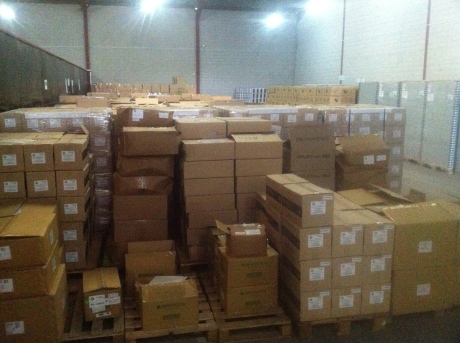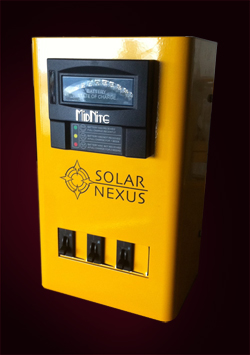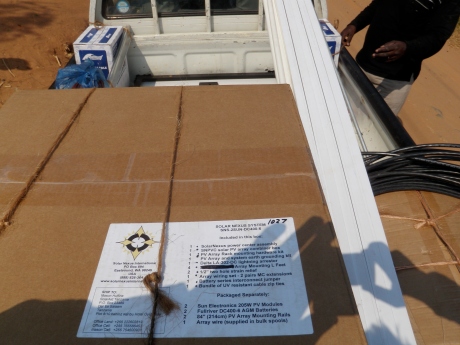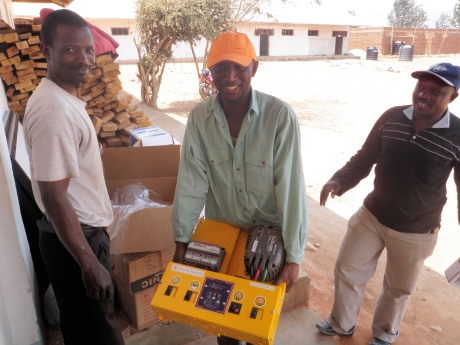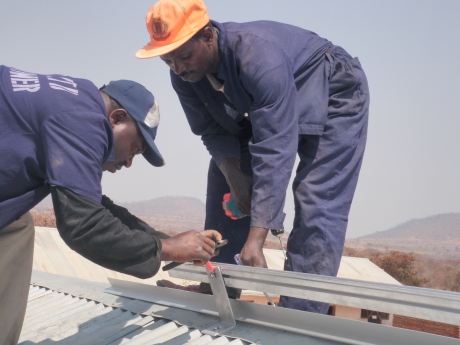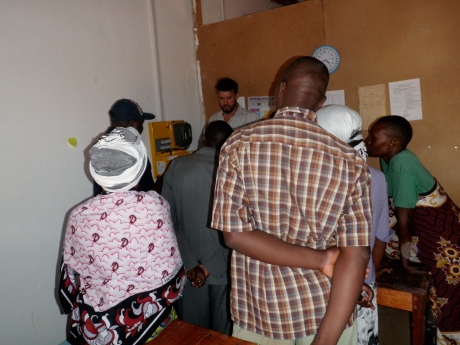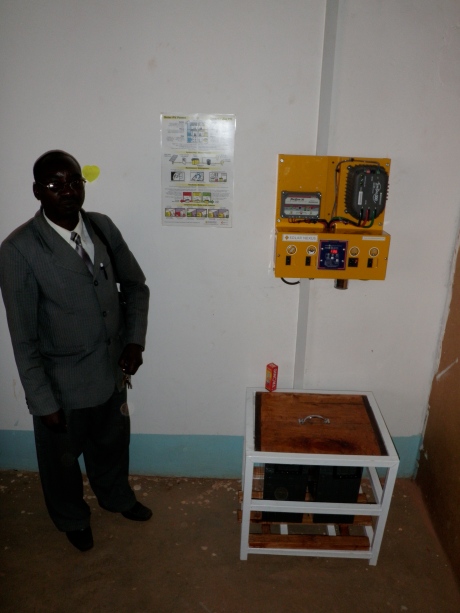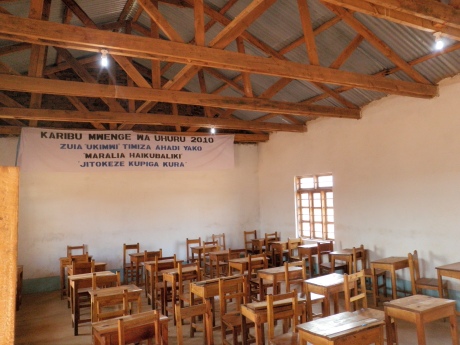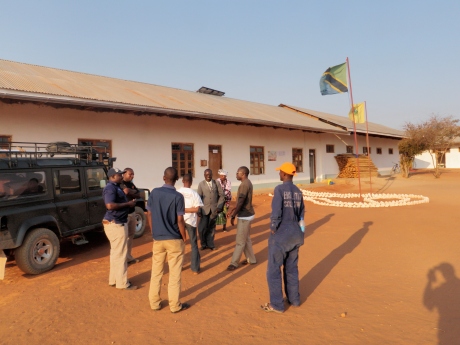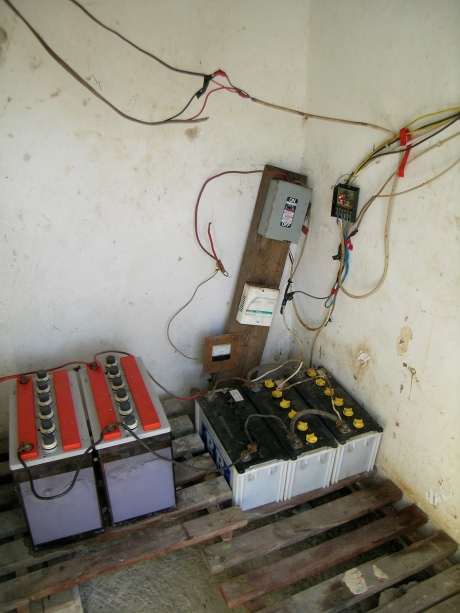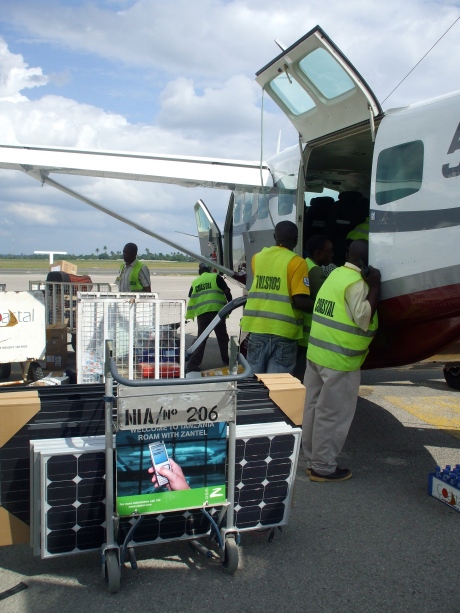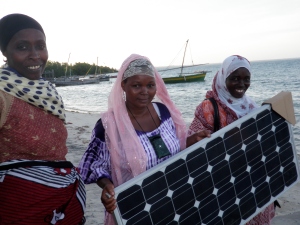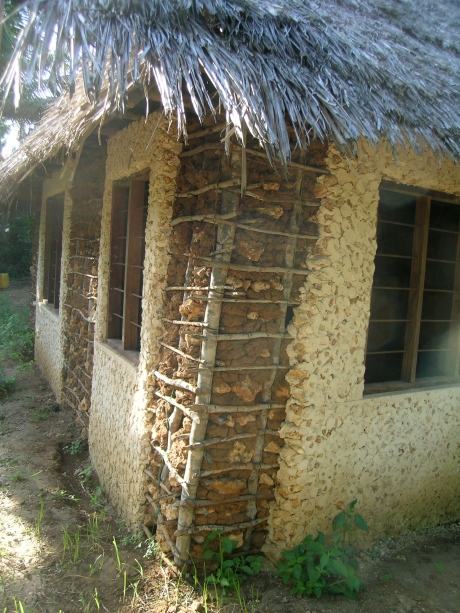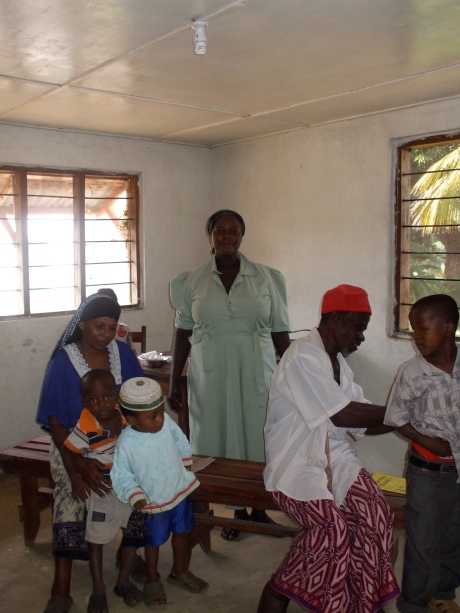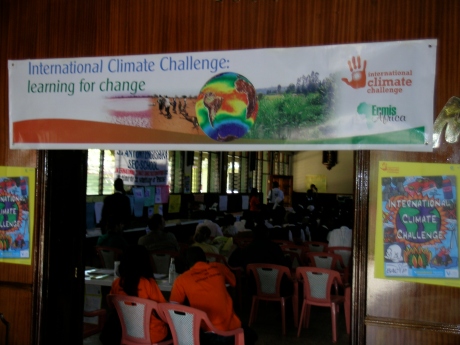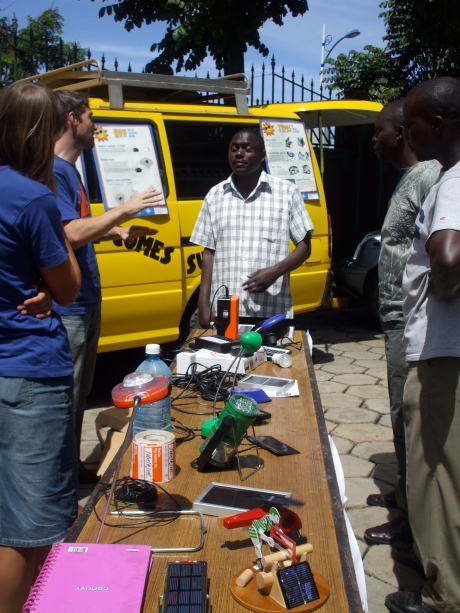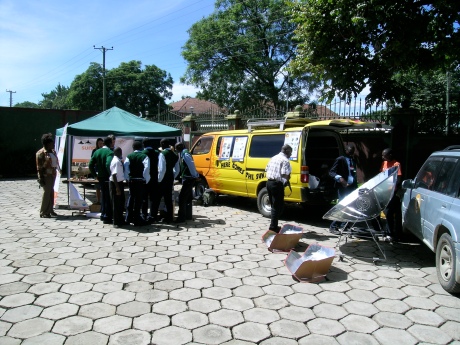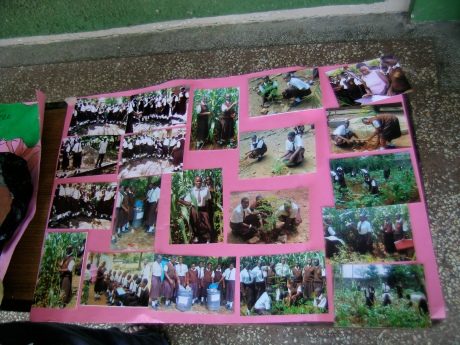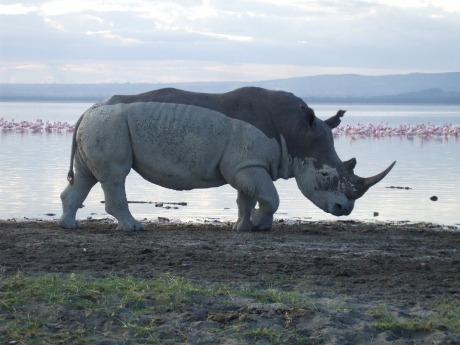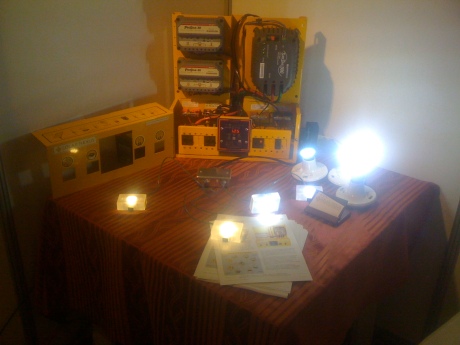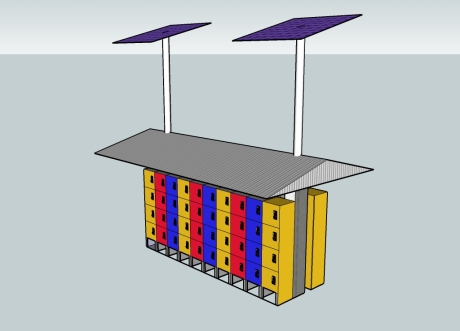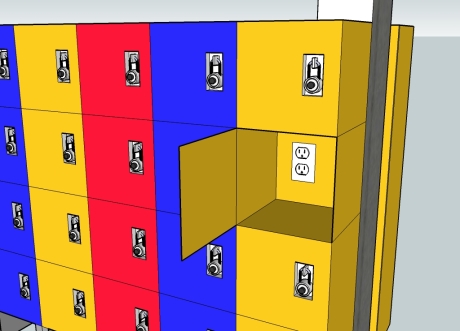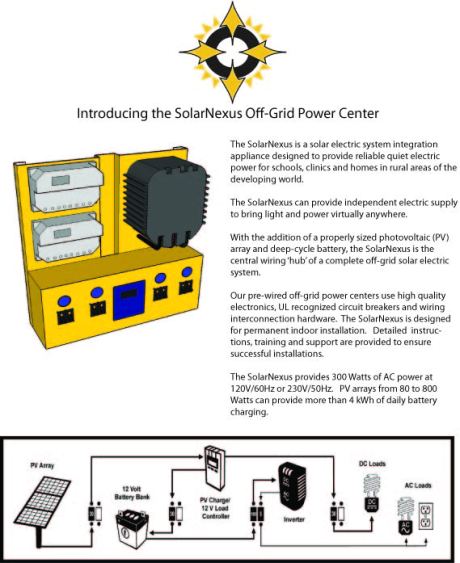Back to Tanzania
April 14, 2013
Introducing the MicroNexus Power Center
January 23, 2012
Here’s our newest product, the MicroNexus Power Center!
We are excited to be sending several hundred complete, pre-integrated 12V PV systems featuring the MicroNexus to schools in Tanzania in the new few months.
The MicroNexus is a circuit protection and wiring integration enclosure that becomes the heart of a small off-grid solar PV system. Connect your solar panels, attach your batteries, and you’re ready to power up! The MicroNexus handles the control of solar PV charging of the batteries, and distributed the flow of current from the battery out to your lights and appliances. We pre-wire the Nexus for ease of installation under remote field conditions or by DIY non-professional installers. Each MicroNexus contains a charge controller (5-30 Amp), a battery meter, room for up to six panel-mount circuit breakers (comes with 3 DC breakers standard), two insulated busbars for DC load distribution, a ground (earth) busbar, and has a variety of knock-outs for easy conduit or “trunking” access.
We designed the MicroNexus to power low-power DC computer labs in East African schools. But its remarkable versatility makes it an excellent choice for a wide variety of off-grid applications. Add an inverter, and run your AC power loads– with up to a 100 Amp DC breaker installed. Need more charging power? The MicroNexus can scale up for PV charge controllers up to 80 Amps or multiple controllers in parallel.
The unit can be purchased alone, or as part of a complete pre-wired PV system, including modules, batteries and all the required interconnections and balance of systems hardware. Give us a call — we’ll custom design and build a MicroNexus system to meet your needs.
As with all SolarNexus products, we source from the best in the business and stand behind our products with a lifetime limited warranted. Creating happy off-grid customers is why we’re in business!
“Education is Light”
January 10, 2012
Here’s a great little video shot by John Keane of SolarAid of the first SolarNexus system installed in Kenya.
First SolarNexus Systems Installed by SolarAid Tanzania
October 6, 2010
We’re happy to announce that the first 10 Solar Nexus Systems for SolarAid Tanzania have been installed on schools in southern Tanzania. These systems were shipped as complete kits, similar to the one shown on this YouTube video.
Mason at SolarAid sent me this series of pictures from one of the installations on a rural school about 100 km from Iringa, which itself is 500 km west of Dar es Salaam. This is a LONG day’s trip on rough roads, some paved and many not. This installation was completed in a single day but it takes a full day to get there and get back so its extremely important that the system works reliably and does not break down and require a trip out by SolarAid or a technician.
This kind of project is a perfect example of expedition style solar power system installation. The installers need to know they have every component and small part they’ll need to complete the installation, which in most cases includes wiring all the load circuits for the buildings in addition to the solar power system. The Solar Nexus System makes the installers job easier by including all the parts needed for the energy generation and storage side of the system. The electricians just need to pack the wire, conduit, lights, switches and outlets for the load circuits. The nexus is the center of the system and contains the power conditioning electronics, meter, circuit breakers and load distribution bus bars for 230VAC and 12VDC circuits.
The Solar Nexus System is a whole system approach to off-grid PV system installations in remote places.
Solar Empowerment for an African Island Community
June 30, 2010
We recently had the opportunity to work with our friends at SolarAid Tanzania to install and rebuild three different off-grid PV systems on a small Tanzanian island. We had a great time on beautiful Chole Island and enjoyed the warm hospitality of that rural African community. You can read SolarAid’s account of the project on their blog here.
I’m a huge fan of islands. I grew up and currently live on a great one, of course, and I named my company Island Energy Systems for the additional reason that off-grid power systems are electrical islands, in the sense of being geographically delimited systems. So last year, on my first trip to Tanzania, I was very interested to learn about the Mafia Archipelago, the less-developed southern neighbor of Zanzibar in the Spice Islands of Tanzania. I started to explore the options for doing off-grid solar projects on some of those islands, especially those that have no grid infrastructure and little chance of getting the grid in the future. When I was planning our recent trip to Tanzania I suggested to Mason at SolarAid that perhaps Mafia would be a good place to install the SolarNexus system that we’d be bringing with us. As it turned out SolarAid in London had already suggested that Chole Island near Mafia would be a good place to do some projects. Mason had begun communcating with island community leaders and the proprieter of an eco-resort on Chole, who were supportive of the idea and motivated to make it happen. So when we arrived in Dar es Salaam the plan was already taking shape, Mason had been out to Chole for a site visit and had survey notes and a bunch of photos of the three facilities we’d be working on. Two of the sites, the health clinic and the school, had 10 year old PV systems that had been installed by a Norwegian NGO but the batteries had all failed and one of the systems, the health clinic, was in really bad shape. The funky wiring on this system was a classic example of what we call “Solar Spaghetti” because of the crazy messy wiring.
Chole Island is a two square kilometer island with almost a thousand residents off the southeast side of Mafia Island, in the Indian Ocean south of Zanzibar. The island is inside the Mafia Island Marine Park, surrounded by coral reefs teeming with tropical fish. Chole is too small to be seen on this map, but you can get a general idea of where it is located.
SolarAid Tanzania worked with Coastal Aviation to arrange for a discounted charter flight to carry six passengers and a big pile of solar equipment, including almost 1500 lbs of sealed batteries, from Dar es Salaam to the Mafia Island airport in Kilindoni. In addition to the materials for the 3 systems we planned to install we had a bunch of boxes of SolarAid’s “microsolar” products to be sold to the local people through the SolarAid franchise agent on the island. We were six people, myself and Golda – NABCEP certified PV installers from Solar Nexus International, Harry and Hamadi – PV installation technicians from Ensol Tanzania, LTD and Mason and Stephen from SolarAid Tanzania.
The flight to Mafia takes about 30 minutes. We were met at the Mafia airport by a delegation of community leaders from Chole Island. They came with two pickup trucks that we loaded with all the equipment and drove another half an hour across Mafia to the small village of Utende, from where the boats leave to go to Chole. We loaded the ton of solar equipment into yet another vessel to complete the final leg of our journey across the final few kilometers of water to arrive at Chole in the golden evening light. As we approached the shore we saw that a large group of women and children had come out to the shoreline to greet and welcome us with songs, including one they had just written for the occasion of our visit. Here’s some pictures of the boat loading and unloading, and one shot of the final leg of the journey, about 500 meters across the island on foot.
Our arrival to the island was incredible. It seemed like the entire community had come out to greet us. The women were dressed in their finest clothes and every kid on the island was there, excitedly looking at the huge pile of equipment that quickly formed on the dock. They had one cart and several bikes to move the batteries on wheels but everything else went on top of a head or in the arms of somebody. Golda loaded up some kids with fairly heavy rolls of wire without realizing quite how far we had to carry it all across the island. It was quite a procession of loads that transported the equipment along the path to its final destination!
We stayed in a guest house near the ‘Learning Center’, a facility built and run by the Chole Society for Women Development (CSWD). A core group of women from the CSWD 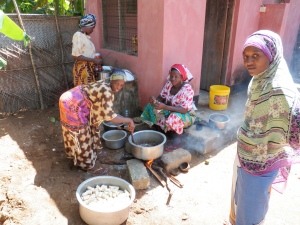 took great care of us during our time on the island, cooking up great meals and steaming cups of spiced masala chai every day.
took great care of us during our time on the island, cooking up great meals and steaming cups of spiced masala chai every day.
The first project we did was for the Learning Center. They had an old, small system that had stopped working almost completely. During the day the PVs could get the battery voltage high enough to turn on the 12 volt loads but once the sun went down the ‘low voltage disconnect’ (LVD) would turn off the lights after a short time. The CSWD uses the Learning Center for evening classes for adults and to provide extra instruction and test taking help for primary and secondary school students in need of more assistance. They need good lighting for the classrooms and have plans to add computers and a wireless internet connection in the future. We installed the SolarNexus Powercenter that Golda and I had brought from Seattle for our booth display at the Lighting Africa conference in Nairobi and had used for installer training sessions in Nairobi and Dar es Salaam. It was a great feeling to install the first SolarNexus Powercenter in Africa! 
We also used a SolarNexus PV combiner box and MC4 “plug and play” connector extension cables to wire the 3 x Suntech 135 Watt module array without cutting the pre-wired connectors off the modules. The SNPVC has insulated bus bars for parallel combining modules inside an aluminum enclosure. This method of string combining is much better than the current standard practice in Africa of simply twisting the wires together and then tightly wrapping with insulating tape. Over time wires not securely terminated and secured can become loosened by the effects of temperature extremes, wind and moisture. We ran PVC conduit to protect the wiring to the array combiner box and used UV resistant nylon zip ties to secure the wiring to the rack.
Unlike most PV installations in the US, most African installations also include wiring all the load distribution circuits. Harry and Hamadi and their crew of Chole resident climbed all over the two buildings pulling wire for a dozen lights and a few select AC receptacles. They were really quick and relatively tidy but when we flipped on the switch to power up the AC loads the inverter beeped a warning and a red light came on indicating a fault in the AC output circuit. It was getting dark by this point (of course) but we got out the headlamps and went back up into the attic to find the problem. Turns out a poorly placed staple had punctured thru the cable in the attic and shorted the hot wire to the ground wire. We replaced a short section of wire and soon we had all the lights on and a bunch of battery chargers plugged in. Solar empowerment for Chole Island!
The other two projects were on the the opposite side of the island, about a ten minute walk through coconut, mango, banyan and banana trees, past thatched roof earthen houses along a network of footpaths. It took a few times getting lost before we learned which big trees to use as landmarks to find the route back and forth between the project sites and the guest house. The giant ‘flying fox’ fruit bats roost in a few selected trees close to the guest house, so we could use their screeches to help get us home. Thank goodness for foam ear plugs that allowed us to sleep through that screeching at 4 am when the arrived back to the trees after every night of eating fruit on Mafia!
For the last two systems we used parts obtained locally through Ensol. We built wooden ‘power boards’ in the style that SolarAid has helped to develop using several small plastic circuit breaker boxes and AC rated breakers. The contrast between installing with those materials and the first system using SolarNexus integration hardware was dramatic. The locally available materials (terminals, breakers, enclosures, etc.) are just not as appropriate for use in PV systems and will not be as efficient or durable as parts designed for those particular applications. For more information on the Solar Nexus approach to high quality off-grid system integration please see our website at solarnexusinternational.com.
We’d like to thank our friends and partners at SolarAid for their great solar empowerment work in Africa and for allowing us to be a part of it. Thanks also to our new friends and all the great people of Chole Island, the Chole Mjini Lodge and the Shamba Kilole Lodge on nearby Mafia Island for making our visit so enjoyable. We hope to get back out to the Mafia Archipelago next year to bring more solar empowerment to Chole and the other remote island communities. Stay tuned and sign up for news from Solar Nexus International on the website or at the Solar Empowerment Network to learn more about the Solar Empowerment Corps.
Solar Roller Safari
June 20, 2010
One of the highlights of our recent trip to East Africa was a weekend trip to Nakuru, about two hours north of Nairobi, Kenya.
After the Lighting Africa conference we spent a day at the office of SolarAid Kenya for a few meetings and to teach an off-grid fundamentals class for their staff and contractors. SolarAid’s Head of Programmes John Keane and Solar Roller Coordinator Courtney Faucett invited us to tag along with them to an ‘International Climate Challenge’ event for secondary school students from around the region. We rolled in the “Solar Roller”, a mobile solar educational roadshow, packed with demonstration products and displays to present SolarAid’s micro-solar product line and spread the renewable energy message.
We drove up from Nairobi and arrived while the event was already in full swing. Over 300 secondary school students from around central Kenya were there representing their schools environmental groups and showcasing their eco-activities. In addition to SolarAid’s display outside there were ten or more local NGOs there to present about their approaches to environmental protection and sustainability. I kept thinking about hard it would be to get that kind of attendance from US high school students! The irony of the whole thing is that most of these kids families don’t even have electricity in their homes, let alone multiple vehicles per family! Their carbon footprints are tiny. The kids were smart and enthusiastically interested in the information being presented. They were intrigued by the Sunny Money products and wanted to know where they could purchase them.
After the event we drove a few kilometers down the track to Lake Nakuru National Park. We got simple cheap rooms at a hostel run by the Kenya Wildlife Service and explored the park by vehicle. Heres a few pictures of some of the animals we got to see.
Lighting Africa conference
May 28, 2010
We’ve spent the last few days at the World Bank/IFC sponsored “Lighting Africa” conference here in Nairobi, Kenya. There were over 750 attendees, speakers and exhibitors from all over the world. It was a diverse group of NGO, governmental and off-grid lighting industry folks. We had a booth to display the SolarNexus and introduce SNI as a new distributor in Africa. It was great to meet so many people working in the field, to see their reactions to the SolarNexus hear their thoughts about the possibilites for our approach in the African market. Our product offerings are substantially larger and more expensive than most of the exhibitors, but we found plenty of people who had experience with larger scale hard-wired solar power systems and appreciated the pre-integrated approach that the SolarNexus facilitates. I have a stack of business cards and notes on prospective leads to follow up with once I get some time.
We also had some LED lights on display from Holly Solar which were a big hit. People really liked the durable “brick” style lights with integrated switches, and the bright light output with very low current consumption makes the ideal for use off-grid PV systems. I’ll definitely be including these lights in our product catalog.
Here’s what the SolarNexus on display in our booth looked like:
Solar Nexus Safari 2010
May 7, 2010
Hi folks,
We’re getting geared up to hit the road for a few weeks to unveil the SolarNexus power center to East Africa! Golda and I will be flying into Nairobi on May 16th, where we will be exhibiting the SolarNexus at the Lighting Africa conference being organized by the World Bank and the International Finance Corporation. This will be a great opportunity to show off our new approach to off-grid power system integration for hundreds of governmental, NGO and business decision makers working on off-grid lighting and power issues across Africa and other parts of the developing world.
After the Lighting Africa conference we’ll be putting on a one day off-grid PV training session for the staff of SolarAid Kenya at their office in Nairobi. SolarAid in Tanzania has been a great partner and our first customer for a bulk purchase of SolarNexus systems. We enthusiastically support the efforts of SolarAid and hope to work with them to bring high quality institutional power systems to other countries.
From Nairobi we’re headed to Arusha, Tanzania, where we’ll participate in the Tanzania National Solar Energy Day event being produced by the Tanzania Solar Energy Association (TASEA). After that we’ll be in Dar es Salaam for about a week, doing SolarNexus training sessions for the dealers and installers who will be installing the 30 systems currently enroute via ocean freight to SolarAid Tanzania.
We hope to finish out the trip with some time on Chole Island, in the Mafia Island National Marine Park. Mason at SolarAid TZ has been working with a lodge on Chole that is supporting installation of PV systems on a school and a health clinic on the island. We hope to install a SolarNexus system at the school and also do some repair and service to an existing system on the health clinic. After all that we hope to have some time to relax on the beach and take in a little snorkeling before getting back on a plane to come home.
Stay tuned to this blog and our Facebook and Twitter pages for updates and notes from the field!
Eric
Battery Charging Lockers for Haiti?
February 25, 2010
Ever since the earthquake in Haiti I’ve been thinking about how we could get some small scale solar empowerment to those poor displaced people. Shanty towns and tent cities are the sad reality of Haiti for the foreseeable future. Nano-scale PV lanterns and small battery charging systems could get them some battery powered lights, radios and cell phones, but they’d have to leave the panels outside in the sun to charge, which would make them easy targets of thieves. A SolarNexus system or micro-grid could power a community of tents for LED lights and cellphone charging but then you’re stringing wires all around and shared batteries will get overused.
Then we had this idea:
The basic concept is to install banks of steel lockers to use as central community charging stations. Every locker would have AC and/or DC charging receptacles inside and they’d be rented by the week. It could provide basic electrical services in the form of battery charging for portable lights, mobile phones and small electronic devices like radios. The lockers would also be a secure place to store small valuables and money. Limiting the access to electricity to small battery charging only would keep the overall energy demand low and easily supplied by a modest scale off-grid system. If we figure 5 Watts of PV per locker (roughly 25 Watt-Hours of battery charging per day) a 400 Watt SolarNexus system could run 80 lockers.
The electric grid in Haiti is almost beyond repair. Check out this recent Washington Post article. Even before the earthquake it was a complete disaster. Maybe its time to re-think the grid for places like Haiti. Battery powered devices can provide many of the basic energy services we need from electricity. Central battery charging kiosks run as businesses could be a new industry and engine of economic development. Multi-scale distributed RE could re-power Haiti in a cleaner and better way.
